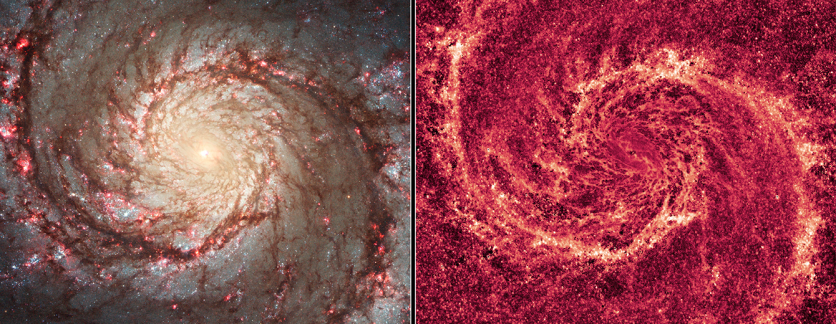The gracefully curving arms of the majestic spiral galaxy, which is called "M51", look like a huge spiral staircase leading you to the very heart of space. But these arms are actually long lanes of stars and gas entwined with dust. These strikingly gorgeous arms are a signature of so-called "grand-design spiral galaxies."

Factories of Stars
Published by NASA on their Tumblr page, the M51 or the Whirlpool galaxy wields majestic arms that hold a very significant value: they are factories of stars, involving the compression of hydrogen gas and generation of a million new stars.
The image was captured by NASA's Hubble Space Telescope in visible light with its Advanced Camera for Surveys. Staying true to its nickname, the Whirlpool Galaxy strokes characteristics of a typical galaxy with its pink star-forming regions, dazzling blue strands of star clusters, and of course, its glittering curved arms!
Several astronomers believe that the Whirlpool's curved arms are specifically prominent due to the effects of close interaction with NGC 5195, which is a small, yellowish galaxy located at the outermost tip of one of the M51's arms.
This compact galaxy looks like it is tugging on the arm. In turn, the tidal forces collide to activate the formation of new stars. Hubble Telescope's provides a clear view of the galaxy showing that NGC 5195 is trailing behind M51.
It is worth noting that this small galaxy has also been gliding past the Whirlpool for hundreds of millions of years, according to NASA's statement.
This Hubble's beautiful image of the M51 displays the red as the infrared light and also the hydrogen found within large star-forming regions. While the blue hues represent the hot and newly-born stars, and the yellow colors are attributed to the older stars.
The galaxy was discovered by Charles Messier in 1773. M51 is located 31 million light-years away from the vicinity of planet Earth and found within the constellation Canes Venatici. M51 has an apparent magnitude of 8.4 and can be found within a small telescope more visibly during the month of May.
Such closeness of the Whirlpool galaxy's mesmerizing face-on view of our planet gives astronomers the chance to learn more about a classic spiral galaxy's structure and how it forms millions of stars in its regions.
As of now, the Hubble Space Telescope has launched its #GalaxiesGalore, where everyone can enjoy more galaxy content and new space images by following the hashtag on Hubble's Twitter, Facebook, and Instagram.
Read Also : NASA's Hubble Telescope Gains New Milestone In Solving Mystery of Universe's Expansion Rate
A Two-Faced Spiral Galaxy
Interestingly, there's more to this Whirlpool Galaxy than meets the eye.
The Hubble Space Telescope has captured two dramatically distinct faces of the spiral galaxy with this photo.

The photo at left was taken in visible light, featuring all the characteristics of a typical spiral galaxy with its curving arms, pink star-forming regions, and blue strands of star clusters. This heavenly-looking image is in stark contrast with the photo at the right, which looks like a raging ball of fire.
The other face of M51 reveals its skeletal dust structure, which is captured in near-infrared light and remains to be the sharpest view of the dense dust in the Whirlpool galaxy. These images were presented at the American Astronomical Society meeting in Seattle, Wash, last Jan. 2011.
Related Article : NASA's Hubble Telescope Reveals Dazzling Slice of the Universe called "Little Sombrero"
This article is owned by Tech Times
Written by Joaquin Victor Tacla




